What I enjoy most about conferences are the ideas. Ideas + people make for rich sessions and engaging discussions. Beautiful garden settings also help.
This year’s American Public Garden Association conference was held in Hamilton, Ontario. The Association and its over 600 member gardens host an estimated 120 million visitors annually. Conferences provide connections to far away people and places but only a small percentage of garden staff can typically attend. How can ideas generated at conferences be channeled into practical actions at home? I created a Top 10 list of ideas and action points in order to start the conversation:
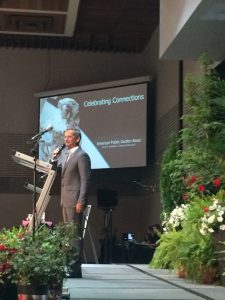
Chris Hadfield, Plenary Speaker
Action 1 – Celebrate that I get to work at UBC Botanical Garden. The greatest seed that I take away from garden conferences is that garden people around the world really love our Garden. People ‘ooh’ and ‘ah’ when they recollect being here. Its an important reminder of how lucky we are to work in such a beautiful place.
Action 2 – Share the Association’s recent statement in support of the Paris Climate Accord. Gardens are important places for climate change and sustainability education, research and advocacy. At the conference, I organized two sessions where I talked about our Sustainable Communities Field School. Gardens are an ideal place for designing sustainability education and research and supporting their communities to take action.
Action 3 – Share with staff and colleagues the City of Toronto’s Organic Landscape Maintenance Guidelines. These guidelines were created for a remediated park called Corktown Commons. They provide landscape information on soil health, water use and quality, energy use and climate, plant selection, pest management and more. Figuring out which aspects of these guidelines we already practice and planning to bring in new techniques would a great first step.
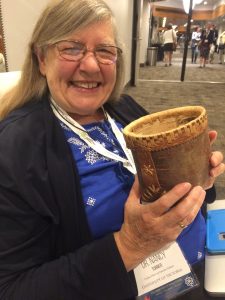
Dr. Turner with berry-picking basket
Action 4 – Learn more about First Nations’ technology and innovations. One of the plenary lunches featured ethnobotanist Dr. Nancy Turner. She completed her PhD at UBC Botanical Garden in the early 1970s with Roy Taylor and has spent her career receiving teachings from Indigenous elders and communities across British Columbia. She spoke about Indigenous agriculturalists of North America and how technologies such as baskets were used for berry harvesting. We are looking to plan a speaking event next fall or winter to explore these topics in more detail.
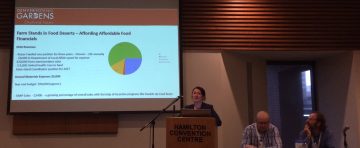
Chatfield Farms team
Action 5 – Explore ways to enable exchange programs between Gardens. Colleagues and friends from Chatfield Farms at Denver Botanic Garden hosted a great session about their agri-tourism events. Similar to our Apple Festival, their events (Pumpkin Festival, Corn Maize and Lavender Festival) provide significant revenue to support their other food programs. An exchange trip between gardens would be a fantastic way for staff to share knowledge and best practices for these types of programs.
Action 6 – Discover ways to increase diversity and inclusion at gardens. The theme of increasing diversity and inclusion at gardens was threaded throughout many sessions at the conference. It was also significant that the conference this year was in Canada. The process of reconciliation being led by Reconciliation Canada and others was apparent. Americans took notice and asked questions about how gardens and communities are working to revitalize relationships among Indigenous peoples and all Canadians. You can read the Associations Diversity and Inclusion policy statement here.
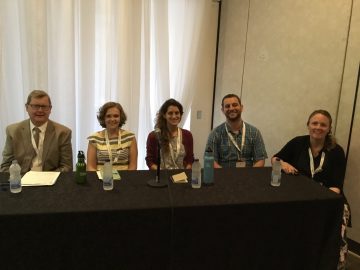
Food and agriculture discussions
Action 7 – Be prepared to have tough talks. One of the reasons I attended this conference is that I chair the Association’s Food and Agriculture Professional Section. This group aims to explore and collaborate on how gardens can tackle and advance critical food literacy. Critical food literacy refers to the ability to understand multiple perspectives and larger sociopolitical contexts involved with food (see reference here). There is great opportunity for gardens to host critical conversations about complicated topics such as biotechnology, cultural diversity and the future of food. It will be hard work, but these are the conversations we have to have if we are to tackle the issues ahead of us.
Action 8 – Explore travelling exhibition ideas to support gardens in tackling complex issues. Garden educators are expected to know a lot about many things. Research presented by Erin Kinley found that exhibits are inclusive and effective educational tools for gardens.
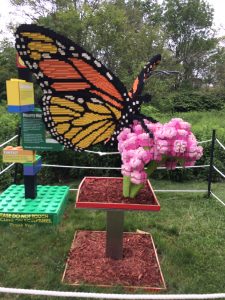
Monarch LEGO sculpture
Action 9 – Visit more gardens. This is really one of the greatest things about garden conferences: having the opportunity to see and hear about the diversity of gardens that grow around the world and the richness of expertise, perspectives and energy directed towards celebrating plants and biodiversity.
Action 10 – Do everything and anything we can to protect biodiversity before it is gone.
Submitted by Tara Moreau, Associate Director, Sustainability and Community Programs, July 7, 2017
